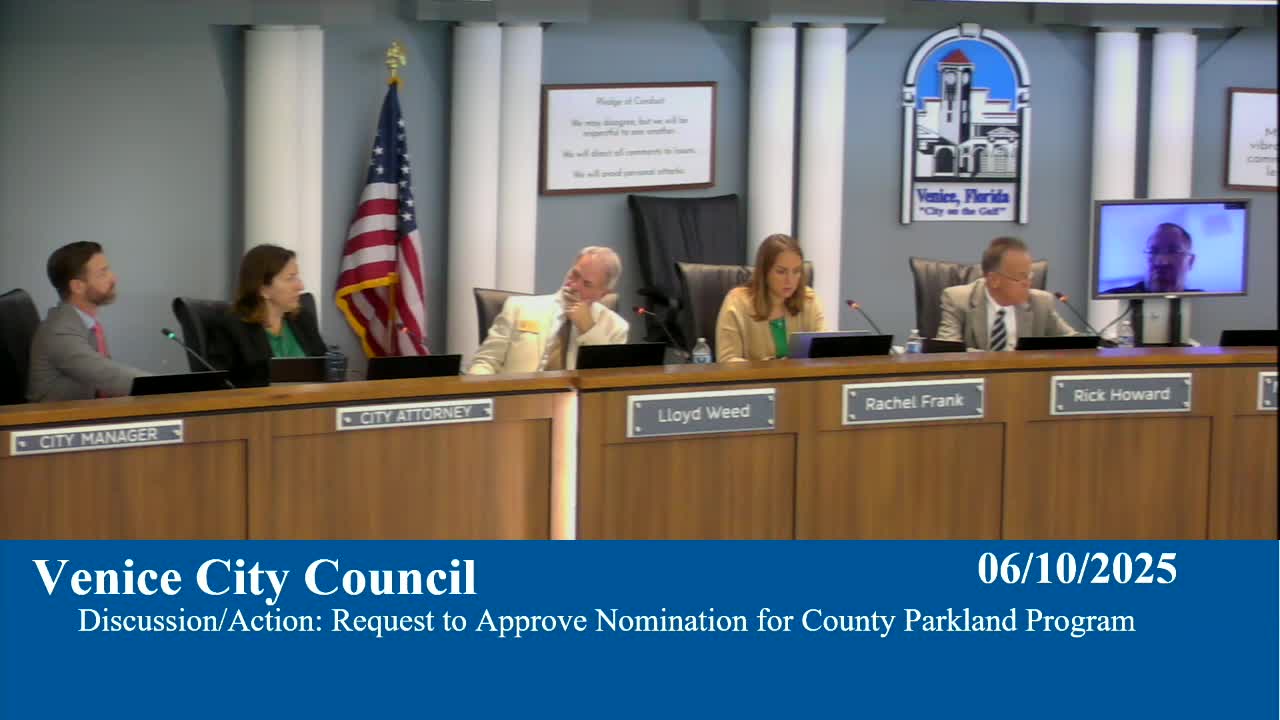Venice council considers rezoning Pine Brook land for neighborhood park development
June 10, 2025 | Venice, Sarasota County, Florida
This article was created by AI summarizing key points discussed. AI makes mistakes, so for full details and context, please refer to the video of the full meeting. Please report any errors so we can fix them. Report an error »

In the heart of Venice, Florida, city council members gathered under the bright lights of city hall to discuss a proposal that could reshape a neighborhood's landscape. The focus of the meeting was a parcel of land currently zoned for high-density development, which could potentially be transformed into a neighborhood park.
Council discussions revealed that the property, originally designated for a nine-story building with a density of 110 units, may soon see a significant zoning change. If approved, this shift would convert the land into open parkland, a move that has garnered support from local residents. The planning director was called upon to outline the rezoning process, emphasizing that such a change would not only decrease density but also enhance community space.
Jim Martin, a resident of the nearby Pine Brook South neighborhood, passionately advocated for the park's development. He described the land as a "pearl" in a string of residential properties, highlighting its proximity to a rehabilitation facility. Martin argued that a park would provide essential outdoor space for residents, particularly those who might otherwise have limited access to nature. He framed the proposal as a "win-win" for the neighborhood, the property owner, and the city, aligning with the broader vision of enhancing quality of life through green spaces.
Loretta Bear, another Pine Brook South resident, echoed Martin's sentiments. She shared her efforts to nominate the property for Sarasota County's land acquisition program, noting its compatibility with community needs. Bear pointed out that the small size of the parcel—approximately 2.3 acres—makes it an ideal candidate for a neighborhood park, which would serve not just Pine Brook South but also surrounding areas.
As the meeting progressed, the council members listened intently to the community's desires for more green spaces, reflecting a growing recognition of the importance of parks in urban planning. The discussions underscored a collective aspiration to foster a more connected and vibrant community through thoughtful land use.
The outcome of this proposal remains to be seen, but the voices of residents like Martin and Bear have clearly resonated with city officials. Their advocacy for a neighborhood park highlights a crucial intersection of community needs and urban development, setting the stage for future discussions on how Venice can continue to grow while preserving its charm and enhancing the quality of life for its residents.
Council discussions revealed that the property, originally designated for a nine-story building with a density of 110 units, may soon see a significant zoning change. If approved, this shift would convert the land into open parkland, a move that has garnered support from local residents. The planning director was called upon to outline the rezoning process, emphasizing that such a change would not only decrease density but also enhance community space.
Jim Martin, a resident of the nearby Pine Brook South neighborhood, passionately advocated for the park's development. He described the land as a "pearl" in a string of residential properties, highlighting its proximity to a rehabilitation facility. Martin argued that a park would provide essential outdoor space for residents, particularly those who might otherwise have limited access to nature. He framed the proposal as a "win-win" for the neighborhood, the property owner, and the city, aligning with the broader vision of enhancing quality of life through green spaces.
Loretta Bear, another Pine Brook South resident, echoed Martin's sentiments. She shared her efforts to nominate the property for Sarasota County's land acquisition program, noting its compatibility with community needs. Bear pointed out that the small size of the parcel—approximately 2.3 acres—makes it an ideal candidate for a neighborhood park, which would serve not just Pine Brook South but also surrounding areas.
As the meeting progressed, the council members listened intently to the community's desires for more green spaces, reflecting a growing recognition of the importance of parks in urban planning. The discussions underscored a collective aspiration to foster a more connected and vibrant community through thoughtful land use.
The outcome of this proposal remains to be seen, but the voices of residents like Martin and Bear have clearly resonated with city officials. Their advocacy for a neighborhood park highlights a crucial intersection of community needs and urban development, setting the stage for future discussions on how Venice can continue to grow while preserving its charm and enhancing the quality of life for its residents.
View full meeting
This article is based on a recent meeting—watch the full video and explore the complete transcript for deeper insights into the discussion.
View full meeting